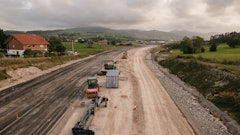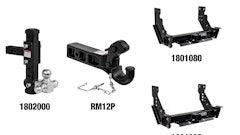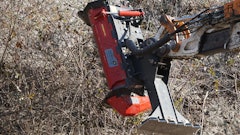
When you're working on your largest job, challenges are certain to come up. Trucco Construction Co., Inc., a contracting firm based in Powell, OH, was recently in such a situation after having a $16.2 million bid accepted for a sanitary sewer line project in Delaware County, Ohio.
Founded in 1990, Trucco handles a variety of construction projects for both private and public entities, from site development to roadbuilding to utility installation. With few exceptions, the company has the internal resources to handle every aspect of its projects. However, the complexities of the Delaware County job required the company to tap into several of those resources.
The project called for construction of a 4-mile sanitary sewer line to serve a rapidly developing 21-sq.-mile area.
Specifications involved connecting the new line to the existing system, which required construction of tunnels beneath the Olentangy River.
In addition to boring holes for 500-ft.-long underwater micro-tunnels, and digging miles of pipe trenches, Trucco had environmental issues to contend with. This particular stretch of the Olentangy fell within a 22-mile tract designated as scenic. And along with the potential impacts to the quality of the river, Trucco had to consider how varying construction methods might affect the structural integrity of several million-dollar homes in the area.
Before trenches for sewer pipe could be excavated, solid rock had to be removed from about half of the 4-mile work area. "Our intent was to blast the rock with dynamite," says Nick Clarke, Trucco project manager. Once dynamiting began, however, Trucco found it difficult to keep bore holes open in the overburden of the rock. Alternative methods to make blasting possible were deemed expensive and would have held up the excavating crew.
With only 18 months to complete the project, Trucco chose to use a hydraulic hammer. "We experimented with our hammers," says Clarke. "The rock was breakable. We just needed a larger hammer to put production in line with our schedule."
Bigger proves best
After comparing a few models, Trucco purchased the Atlas Copco HB 7000 hydraulic breaker attachment, which has a service weight of more than 7 tons. "We thought if we're getting a hammer, we should get the biggest," says Eric Berenstein, Trucco equipment manager. An 80-ton Komatsu excavator was also purchased for use as the carrier.
Trucco needed to dig trenches to an average depth of 20 ft. For the areas of rock, the top 10 ft. of the trench cut was overburden comprised of granular material. The overburden was removed by an excavator, which was closely followed by two or three trench boxes.
Once the crew excavated a given section down to the bedrock, they would bring in the HB 7000. In most cases, rock was broken out to a depth of 2 or 3 ft. at a time across the width of the trench. After the excavator removed the broken rock, the hammer went back in for more breaking. This process continued until the subgrade was reached. The crew then placed gravel on the bottom of the trench and laid pipe. Meanwhile, other members of the crew continuously backfilled the area where pipe was already installed. The entire procedure was repeated multiple times daily, depending on the chosen production rate.
According to Clarke, it wasn't uncommon for the HB 7000 to break 100 lineal ft. of rock in one day. Factoring in a 10-ft. depth and an 8-ft. trench width, the breaker's production amounted to approximately 8,000 cu. ft. of rock per day.
"Given the opportunity, the hammer could probably break more than twice that by itself," says Clarke. "But obviously, with it being tied in with the pipe-laying operation, it's not being used 100% of the time."
A cost-effective alternative
Although breaking the rock was not the method originally planned, it did turn out to be an economical solution.
"There were several variables to consider," says Clarke. "The pipe itself is very expensive. And we needed a large crew at a cost of about $1,500 an hour to do the job. But all things considered, it was just as affordable to break the rock than it would have been to blast. The hammer gained incredible production for the dollar value."
"We've been impressed by zero downtime," adds Berenstein. The HB 7000 features a special wear package, including automatic lubrication and components that self-adjust the breaker's output power in changing conditions.
Keeping the project on schedule for completion in the summer of 2006 was a necessity to future development in Delaware County, which includes proposed sites for a college and a hospital. For Trucco, it was also about upholding its reputation.
"We take a lot pride in our business and set high standards for ourselves," says Berenstein. "A big part of that commitment is doing what's necessary to deliver quality work on every job."
For more information, visit www.ForConstructionPros.com



























